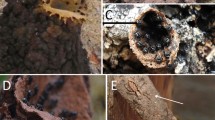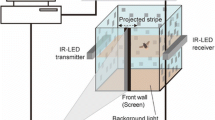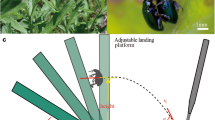Abstract
In comparison to other insects, like honeybees, bumblebees are very effective pollinators. Even though landing is a crucial part of pollination, little is known about how bumblebees orchestrate the final, critical moments of landing. Here, we use high-speed recordings to capture the fine details of the landing behaviour of free-flying bumblebees (Bombus terrestris), while landing on a flat platform with different orientations. We find that the bees have a fairly constant body and head orientation at the moment of leg extension, irrespective of platform tilt. At the same moment in time, the distance to the platform is held constant at around 8 mm (with the exception of low platform tilts). The orientation of the antennae and the first appendage that touches the platform vary between platform orientations, while the duration of the hover phase does not. Overall, the final moments of landing in bumblebees and their close relatives, the honeybees, are similar. However, the distance to the platform at the moment of leg extension and the duration of the hover phase are different in bumblebees and honeybees, suggesting that they are primarily adapted to land on surfaces with different orientations.







Similar content being viewed by others
References
Abrol DP (2011) Pollination biology: biodiversity conservation and agricultural production. Springer Science and Business Media, Dordrecht
Baird E, Srinivasan MV, Zhang S, Cowling A (2005) Visual control of flight speed in honeybees. J Exp Biol 208:3895–3905. doi:10.1242/jeb.01818
Baird E, Kornfeldt T, Dacke M (2010) Minimum viewing angle for visually guided ground speed control in bumblebees. J Exp Biol 213:1625–1632. doi:10.1242/jeb.038802
Baird E, Boeddeker N, Ibbotson MR, Srinivasan MV (2013) A universal strategy for visually guided landing. Proc Natl Acad Sci USA 110:18686–18691. doi:10.1073/pnas.1314311110
Baird E, Fernandez DC, Wcislo WT, Warrant EJ (2015) Flight control and landing precision in the nocturnal bee Megalopta is robust to large changes in light intensity. Front Physiol 6:305. doi:10.3389/fphys.2015.00305
Borst A (1986) Time course of the houseflies’ landing response. Biol Cybern 54:379–383
Breugel F, Dickinson MH (2012) The visual control of landing and obstacle avoidance in the fruit fly Drosophila melanogaster. J Exp Biol 215:1783–1798. doi:10.1242/jeb.066498
Dacke M, Srinivasan MV (2007) Honeybee navigation: distance estimation in the third dimension. J Exp Biol 210:845–853. doi:10.1242/jeb.002089
Evangelista C, Kraft P, Dacke M, Reinhard J, Srinivasan MV (2009) The moment before touchdown: landing manoeuvres of the honeybee Apis mellifera. J Exp Biol 213:262–270. doi:10.1242/jeb.037465
Goodman LJ (1960) The landing responses of insects, I. The landing response of the fly, Lucilia sericata, and other Calliphorinae. J Exp Biol 37:854–878
Goulson D, Chapman JW, Hughes WOH (2001) Discrimination of unrewarding flowers by bees; direct detection of rewards and use of repellent scent marks. J Insect Behav 14:669–678
Honegger HW (1981) A preliminary note on a new optomotor response in crickets: antennal tracking of moving targets. J Comp Physiol 142:419–421
Kirchner WH, Srinivasan MV (1989) Freely flying honeybees use image motion to estimate object distance. Naturwissenschaften 76:281–282
Linander N, Dacke M, Baird E (2015) Bumblebees measure optic flow for position and speed control flexibly within the frontal visual field. J Exp Biol 218:1051–1059. doi:10.1242/jeb.107409
Lunau K, Unseld K, Wolter F (2009) Visual detection of diminutive floral guides in the bumblebee Bombus terrestris and in the honeybee Apis mellifera. J Comp Physiol A 195:1121–1130. doi:10.1007/s00359-009-0484-x
Orth AI, Waddington KD (1997) The movement patterns of carpenter bees Xylocopa micans and bumblebees Bombus pennsylvanicus on Pontederia cordata inflorescenses. J Insect Behav 10:79–86
Pfaff M, Varjú D (1991) Mechanisms of visual distance perception in the hawk moth Macroglossum stellatarum. Zool Jb Physiol 95:315–321
Pohl M, Lunau K (2007) Modification of the innate antennal reaction at floral guides in experienced bumblebees, Bombus terrestris (Hymenoptera: Apidae). Entomol Gener 29(2/4):111–123
Pohl M, Watolla T, Lunau K (2008) Anther-mimicking floral guides exploit a conflict between innate preference and learning in bumblebees (Bombus terrestris). Behav Ecol Sociobiol 63:295–302. doi:10.1007/s00265-008-0661-x
Scheiner R, Schnitt S, Erber J (2005) The functions of antennal mechanoreceptors and antennal joints in tactile discrimination of the honeybee (Apis mellifera L.). J Comp Physiol A 191:857–864. doi:10.1007/s00359-005-0009-1
Srinivasan MV, Zhang SW, Chahl JS, Barth E, Venkatesh S (2000) How honeybees make grazing landings on flat surfaces. Biol Cybern 83:171–183
Tammero LF, Dickinson MH (2002) Collision-avoidance and landing responses are mediated by separate pathways in the fruit fly, Drosophila melanogaster. J Exp Biol 205:2785–2798
Wagner H (1982) Flow-field variables trigger landing in flies. Nature 297:147–148
Willmer P (2011) Pollination and floral ecology. Princeton University Press, Princeton
Acknowledgments
We would like to thank Lana Khaldy for assistance with data analysis. This work was supported by the Swedish Research Council Formas [229-2010-829] the Swedish Foundation for Strategic Research [FFL09-0056] and the Swedish Research Council [2011-4701].
Author information
Authors and Affiliations
Corresponding author
Ethics declarations
Conflict of interest
The authors declare that they have no conflict of interest.
Ethical approval
This article does not contain any studies with human participants or animals performed by any of the authors.
Rights and permissions
About this article
Cite this article
Reber, T., Baird, E. & Dacke, M. The final moments of landing in bumblebees, Bombus terrestris . J Comp Physiol A 202, 277–285 (2016). https://doi.org/10.1007/s00359-016-1073-4
Received:
Revised:
Accepted:
Published:
Issue Date:
DOI: https://doi.org/10.1007/s00359-016-1073-4




